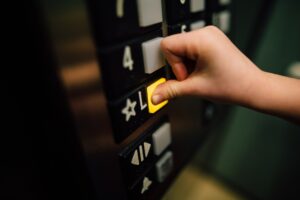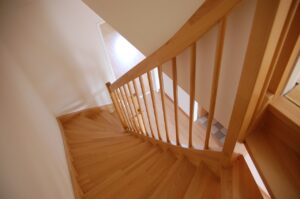In this post we’ll learn all vocabulary relating to buildings, elevators and others in Chinese.
Table of Contents
How to say ‘building’ in Chinese
Thee are several ways to say building in Chinese, these are:
-
楼 – a building, however this is also used to mean floor or storey -
建 筑 – a building -
高 层 建 筑 – “high rise building”, literally “high storey” or “high level building” -
楼 房 – a building of two or more storeys -
大 楼 – a large multi storey building -
房 屋 – a building
Chinese uses classifiers or measure words, so we can’t just say “this building”, but rather we have to say “this (unit of) building”, just as how we say “one piece of paper” and not “one paper” in English. Check out our post Chinese Classifiers: What are they and how to use them and Complete list of Mandarin Chinese classifiers and measure words.
The Chinese classifiers for buildings and houses are:
-
栋 -
座 -
个 , which is a generic classifier in Chinese
Here are some examples:
This building
|
|
this |
|
|
<classifier for buildings> |
|
|
building |
That building
|
|
that |
|
|
<classifier for buildings> |
|
|
building |
These two buildings
|
|
these Note that 这 can mean this or these depending on the context |
|
|
two |
|
|
buildings Note that Chinese words don’t change for multiple (plural) items. So while in English we add an “s” to building to make the sentence “those two buildings”, this is not the case in Chinese. |
Those (several) buildings
|
|
those |
|
|
buildings |
How to say floors of a building in Chinese

The Chinese words for floors of a building are:
-
楼 -
楼 梯 -
层 -
楼 层
To say a given floor of a building such as the 3th floor, putting the floor number in front of
- “3rd floor”
三 楼 or3 楼 - “3rd floor”
三 层 or3 层
Where
You can also add the
- “3rd floor”
第 三 楼 - “3rd floor”
第 三 层 - “3rd floor”
第 三 层 楼
When talking about the number of stories in a building has
This building has five floors,
|
|
this |
|
|
<classifier for buildings> See our post Chinese Classifiers: What are they and how to use them |
|
|
building |
|
|
has |
|
|
five floors |
If you use
This building has a 5th floor.
|
|
this |
|
|
<classifier for buildings> See our post Chinese Classifiers: What are they and how to use them |
|
|
building |
|
|
has |
|
|
a fifth floor |
List of building levels in Chinese

The word for floor is combined with the Chinese number to create the words for “1st Floor”, “2nd Floor” and so on.
| Floor | Chinese Floor |
|---|---|
| B2 | Basement 2 |
| B1 | Basement1 |
| 1 |
1st Floor (British English: Ground Floor) |
| 2 |
2nd Floor (British English: 1st Floor) |
| 3 |
3rd Floor (British English: 2nd Floor) |
| 4 |
4th Floor (British English: 3rd Floor) |
| 5 |
5th Floor (British English: 4th Floor) |
| 6 |
6th Floor (British English: 5th Floor) |
| 7 |
7th Floor (British English: 6th Floor) |
| 8 |
8th Floor (British English: 7th Floor) |
| 9 |
9th Floor (British English: 8th Floor) |
| 10 |
10th Floor (British English: 9th Floor) |
| 15 |
15th Floor (British English: 14th Floor) |
| 20 |
20th Floor (British English: 19th Floor) |
Note that the number of floors is different to some English speaking countries where the floor at ground level is called “Ground” and the one above that is the “1st” floor. Chinese is the same as American floor naming where floors start from “1” and not “G”.
Some other useful vocabulary for levels in a hotel are as follows:
|
|
lobby level |
|
|
restaurant level |
|
|
gym |
|
|
swimming pool |
How to say “take the lift” in Chinese

The Chinese word for elevator or lift is
There are several ways you can say “take the elevator” in Chinese, these are:
- “to ride the elevator”
乘 电 梯 where乘 means “ride” - “to take the elevator”
搭 电 梯 where搭 means “take” - “to use the elevator”
用 电 梯 where用 means “to use”
Finding the elevator
Let’s look at some some useful phrases for finding the elevator:
Where is the elevator?
|
|
elevator (lift) |
|
|
located |
|
|
where |
The elevator is just around the corner.
|
|
elevator(lift) |
|
|
located |
|
|
around (the) corner: – – |
|
|
there |
Does the apartment building have an elevator?
|
|
this |
|
|
building |
|
|
has |
|
|
elevator |
|
|
This character indicates that a yes/no question is being asked. |
The elevator is on the left side.
|
|
elevator |
|
|
located |
|
|
left side – “left” – “side” |
The elevator is on the right side.
|
|
elevator |
|
|
located |
|
|
right side – “left” – “side” |
The elevator is at the end of the hallway on the left.
| rax say=”电梯” newline=”true”] | elevator |
| rax say=”在” newline=”true”] | located |
| rax say=”左边” newline=”true”] | left side |
| rax say=”走廊的尽头。” newline=”true”] | corridors end Here rax say=”走”] means “corridor” and rax say=”尽头”] means “end”. The rax say=”的” |
How to use an elevator in Chinese
| Sentence | Explanation / Break down |
|---|---|
| What floor is it on? |
|
| Push button |
|
| Hold the lift |
|
| hold the lift |
|
| Wait! |
|
| After you. |
Literally “please” |
| which floor are you going to? |
|
| restaurant floor |
|
| which floor is it on? |
Literally “number two” “floor” “thank you” |
| Please press the button for the fifth floor, okay? |
|
How to say “take the stairs” in Chinese

The Chinese word for stairs is
The most common ways to say “take the stairs” in Chinese:
- “walk (up or down) the stairs”
走 楼 梯 where走 means “walk” - “use the stairs”
用 楼 梯 where用 楼 梯 means “to use” - “climb the stairs”
爬 楼 梯 where爬 means “to climb”
Here are some sample sentences for using the stairs:
|
|
stairs |
|
|
located |
|
|
where |
Use the stairs for a few floors rather than the elevator.
|
|
|
|
|
|
|
|
|
|
|
|
|
|
|
|
|
elevator |
She ran up the stairs.
|
|
she |
|
|
ran up – “run“ – “go up” rax say=”上” newline=”true”] |
|
|
stairs |
He climbed down the stairs.
|
|
he |
|
|
climbed down – “climbed” – “go down” |
|
|
stairs |
How to say “take the escalator” in Chinese

There are several ways to say escalator in Chinese, these are:
-
自 动 扶 梯 , literally “automatic”自 动 + “stairs”扶 梯 -
电 梯 , literally “electric”电 + “stairs”梯 -
电 扶 梯 , literally “electric”电 + “stairs”扶 梯 -
电 动 扶 梯 , literally “electrically powered”电 动 + “stairs”扶 梯
Common ways to say “take the escalator” in Chinese are:
- “ride the escalator”
乘 电 k e 扶 梯 where乘 means “ride” - “ride the escalator“
乘 坐 电 梯 where乘 坐 means to “ride”, but is comprised of the characters “ride”乘 and “to take a (bus, car, etc)”坐 . - “use the escalator” where
使 用 means “use”
When taking the escalator, please hold the handrail tightly
|
|
ride |
|
|
escalator |
|
|
when Note that the sentence order in this example is no t the same as English; while the sentence order in English would be “when you ride the escalator…”, in Chinese the sentence order is “ride the escalator, at which time…” |
|
|
please |
|
|
hold firmly |
|
|
handrail |
Take the escalator on your left.
|
|
take (ride) |
|
|
your Although |
|
|
left side’s Literally “left” + “side” |
|
|
escalator |
Take the escalator down.
|
|
take (walk) |
|
|
down |
|
|
esclaator |
The restroom is right opposite the escalator.
|
|
restroom Literally “wash“ + “hands” + “room” |
|
|
(is) just |
|
|
located at |
|
|
escalator’s The addition of |
|
|
opposite |
Let’s take the escalator.
|
|
we |
|
|
take |
|
|
escalator |
|
|
Okay? is a particle that acts as a suggestion and the statement from “we’ll take the escalator” to the equivalent of “let’s take the escalator, okay?” |
Conclusion
This is quite a long post, however feel free to come back and review sections as you become familiar with navigating elevators, escalators, stairs and buildings in Chinese. T
Here is some key vocabulary:
| building |
|
| elevator | |
| stairs |
|
| escalator |
|
| level 1 (ground floor) |
|
| level 2 (the floor above ground) |
|
| Level 10 |
|

